|
Franklin
|
1902
- 1934 |
Country: |
 |
|
H. H. Franklin
Franklin cars were always individual – they had characteristics unlike any other car built in America – and for a time they managed to maintain that independence. The Franklin was perhaps the most unorthodox car to be successfully marketed in the United States; every Franklin ever built was air-cooled, most had full-elliptic suspension and most had wooden chassis frames.
H. H. Franklin was already established as a manufacturer of die castings when he met John Wilkinson in 1901. Wilkinson had designed an air-cooled car engine and Franklin decided to go into production with' a vehicle using this power unit. The first Franklin cars appeared in 1902 and were distinguished by the transverse mounting of their four-cylinder engines, which had the advanced feature of overhead valves (although the inlet valves were atmospherically operated until 1905); there was a two-speed epicyclic gearbox driving the rear axle through a long single chain.
Franklin Model A
Named the Model A, it took two months to build and was on the market by June 23, 1902. It holds the distinction of being the first four-cylinder automobile produced in the United States. Most cars of the time had a single or two-cylinder motor. As Franklin had hoped, the four-cylinder engine eliminated the "bouncing" which the more common one-cylinder engines suffered.
The Model A weighed 900 pounds (410 kg) and traveled up to 12 miles per hour (19 km/h). The auto had a vertical four-cylinder air-cooled engine with overhead valves set transversely at the front of a wooden chassis. The Franklin concept was copied by both Marion and Premier auto makers of Indianapolis, Indiana.
The car was test driven on a short trip to Cortland and returned home by way of Skaneateles one afternoon. S. G. Averell, a New York sportsman and relative of New York Governor, W. Averell Harriman, bought the car on June 23, 1902. He paid $1,200. "It had a chain drive and the engine was mounted crosswise. The four cylinder engine weighing 230 pounds (100 kg) was about one-fourth the weight of the car.
The car had jump spark ignition, splash lubrication and enclosed planetary transmission. The gear ratio was 12-to-1 for low and 4-to-1 for high and there was reverse gear as well as the two forward. The steering gear was on the right, with wheel control." In 1902, Franklin sold a total of 13 cars priced at $1,100 each, and from a modest beginning, went on to become a successful car company. Only thirteen were sold in the first year of production, but this figure was eclipsed by the 1903 sales of 184 cars. In 1905, a new model was announced by the company, which was based in Syracuse, New York. This car had the engine conventionally mounted under a circular bonnet with a dummy radiator grille, and featured a three-speed sliding-gear transmission with shaft final drive. The last of the transverse-engined 12 hp cars was built in 1906.
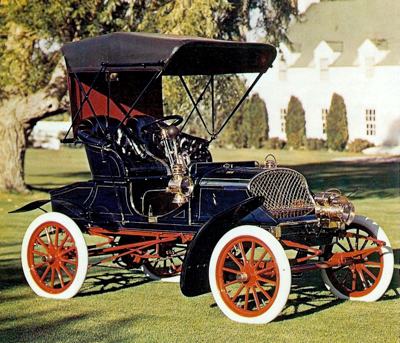 1904 Franklin air-cooled two-seater.
1904 Franklin air-cooled two-seater.
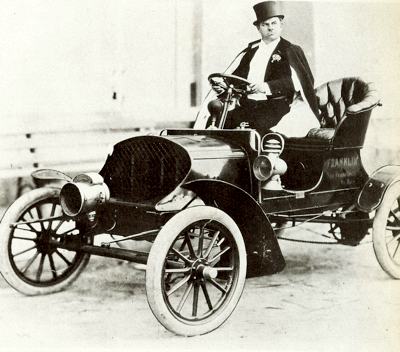 Film actor Wallace Beery, who first starred in the Paramount Picture 'Teddy at the Throttle', seen here posing in the Franklin that broke the San Francisco to New York record in 1904.
Film actor Wallace Beery, who first starred in the Paramount Picture 'Teddy at the Throttle', seen here posing in the Franklin that broke the San Francisco to New York record in 1904.
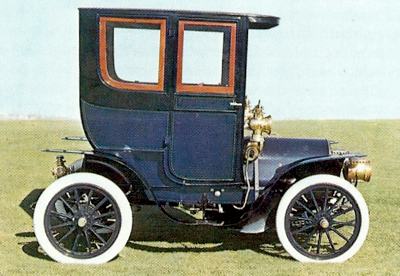 1908 Franklin four-cylinder Brougham - the engine was 2.3 liters.
1908 Franklin four-cylinder Brougham - the engine was 2.3 liters.
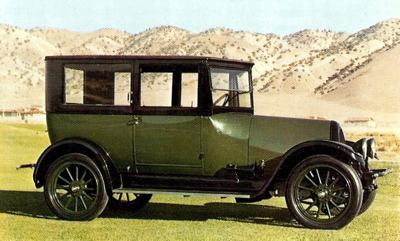 1922 Franklin Six. It had a 'dummy' radiator, and inside the bonnet was a blower fan which blew air around the engine, and over the cylinder cooling fans.
1922 Franklin Six. It had a 'dummy' radiator, and inside the bonnet was a blower fan which blew air around the engine, and over the cylinder cooling fans.
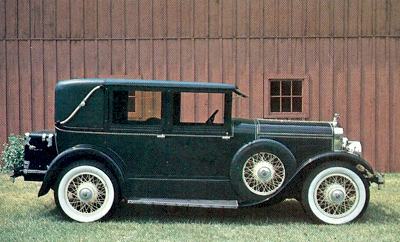 1928 Franklin Sedan. One of these was given to Charles Lindbergh.
1928 Franklin Sedan. One of these was given to Charles Lindbergh.
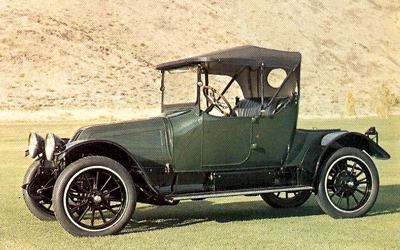 1918 Franklin Roadster.
1918 Franklin Roadster. |
The 1905 in-line-engined models were available with four or six cylinders; the six-cylinder was of notably advanced design, with seven main bearings, a characteristic of all subsequent Franklin sixes. The method of casting the Franklin cylinders was interesting, as the copper cooling fins were placed in the mould before the molten steel, which formed the cylinder barrel, was poured in; this bi-metallic construction was said to give good heat dissipation.
The Washington to San Francisco Run
Cooling was aided, after 1910, by the adoption of a squirrel-cage fan, incorporated in the rear-mounted flywheel. This sucked air through the sealed bonnet over the cylinders. From 1907, the marque had featured automatic control of the ignition advance-and-retard mechanism. The 1912 models had a new design of bonnet plus full pressure lubrication. In 1915, Franklin put one of these cars through a remarkable test: top and second gear were removed from the transmission, which was then sealed, and the car was driven from the euphoniously named Walla Walla, Washington, to San Francisco - a distance of 860 miles - in 83 hours 40 minutes.
The First American Car with aluminum Pistons
The route had been chosen for its severity, passing through the John Day River Gorges, the Harney Desert in Southern Oregon, the Siskiou Mountains and California's Burney Pass. There was another remarkable feature about the 1915 Franklin, apart from its ability to cover long distances without overheating, it had aluminum pistons and was probably the first American car to be equipped in this way. The Franklin had become so successful that other makes of air-cooled car were promoted in an effort to capture a share of the market - there was the Fox and the Holmes, both with a similar design of power unit to the Franklin, but they failed to make a lasting impression.
One of the most potent factors in the Franklin's success story was the intense brand loyalty among owners: in 1927, the company proudly claimed that fifty per cent of its sales was made up of repeat orders from satisfied customers. In 1922 the Franklin range was again restyled, acquiring a rounded dummy radiator, inside which was the blower fan, forcing air up to the top of the bonnet, down over the cylinder fins and crankcase and out beneath the car. This pattern of radiator did not last long. By 1925, the marque was breaking new ground with the J. Frank De Causse-styled Series II, with a handsome square-cut 'radiator' with vertical chrome strips across the grille.
The Franklin Doctor's Coupe
Especially successful was the 1925 Coupe, often referred to as the Doctor's Coupe, produced until 1927; orders for this car were received in such numbers that production quotas were first doubled, then trebled. Beneath the modern styling, however, a Franklin was still a Franklin, with the laminated ash frame which the company claimed was more durable than steel, and the full-elliptic springs which, aided by Wahl two-way dampers, gave an excellent ride on smooth roads and kept the car down very well over bumps, so that really bad roads could be taken 20 mph faster than many contemporary systems allowed.
Among the other unusual features of the car was an electric priming device for the carburetor but, despite its many advanced design features, the Franklin did not acquire four-wheel brakes until 1927, when the 26hp Airman model was announced. One of the first to own the new model was Colonel Charles Lindbergh, but the Lone Eagle did not actually buy his car.
As soon as the news of Lindbergh's solo transatlantic flight was known, Franklin advertising manager, Hugh H. Goodhart, went to H. H. Franklin with the proposal that the company's export representative, Eddie Williams, who was based in Paris, should offer Lindbergh a free car for publicity purposes. The inference was that, as Lindbergh had used an air-cooled engine for his flight from New York to Paris, he had naturally chosen an air-cooled car.
Lindbergh's 'Air Cooled' Franklins
Lindbergh's Franklins were changed for the latest model annually, and he received at least four cars under this scheme. Amelia Earhart was another famous flyer to own a Franklin; so was Orville Wright. About this time, Ray Dietrich became Franklin's styling consultant; he was responsible for some of the most handsome coachwork to be fitted to this marque.
Custom bodies on Franklin chassis proliferated during the late 1920s, almost in inverse proportion to sales, which began to sag in the face of the Depression. The new Series 14, which had the sirocco fan flexibly mounted on the nose of the crankshaft, and a new design of 'radiator' with thermostatically controlled shutters regulating the airflow over the cylinders, made its appearance in 1930, followed the next year by the basically similar Series 15.
It was possible to buy 26 different Series 15 models off the peg, plus an infinite variety of custom-bodied Franklins, yet sales were only 2851, a quarter of what they had been five years before. Moreover, the marque's most distinctive feature, the wooden chassis, had disappeared. Steel frames had made their first appearance at the end of 1927 on long-wheelbase models, and had gradually ousted the older chassis, although partial wooden construction was still evident on 1930 models.
By September, 1931, Franklin Automobile Company announced new low prices on "current models" as low as $1,795 for the Transcontinent Sedan, with similar reductions on 21 other types comprising the completeDe Luxe and Transcontinent lines. This action established the lowest sedan price in the company's 30 years of manufacture of air-cooled cars.
It brought the base price under $2,000 for the first time and put Franklin in the position of the "lowest priced fine car on the market." The amount of reduction ranged as high as $500, representing 22 percent below previous list prices. Prices of
De Luxemodels after the reductions started at $2,395 for the sedan. It was emphasized that the reductions applied to even "the very latest production" which constitutes Series 15 Franklin's incorporating the airplane-type air-cooled motor and the latest body features, along with all the mechanical refinements made "within recent months."
The new scale of prices accomplished the aim the company initiated two years earlier, to introduce their established fine car standards at prices practically on a par with the medium price field. It was also announced at that time that a new national newspaper advertising and promotional effort was meeting with "excellent success."
The Franklin Olympic
In 1932, Franklin introduced a magnificent air-cooled V12, styled by Dietrich. This car not only had a steel chassis but also dispensed with the elliptic springing, using conventional half-elliptic all round. Priced at $4400, the new V12 offered 95 mph performance, but it was the wrong car for the times, and even a forty per cent price cut failed to attract sales. Franklin's last model was the Olympic, but this was a Franklin in engine only. All the rest was Reo, for cheapness. It was as unsuccessful as its more expensive stablemate and, in 1934, the factory produced its last car.
There was an unsuccessful attempt to refloat the company in 1936, while former employees operated the Franklin Automobile Service Company until 1962, catering for the kind of customer loyalty that had inspired Philadelphia businessman Burroughs Sloan to buy 38 Franklins. In 1930, a Franklin engine had been used to power a Waco biplane, and it was in the air that the company name lived on. The engine patents were acquired by the Air-Cooled Motors Corporation, which subsequently became the Franklin Engine Company, specialising in engines for light aircraft and helicopters. A Franklin helicopter engine was used to power the unsuccessful Tucker car of 1947, although Preston Tucker chose, for some inscrutable reason, to convert this power unit to water cooling.
